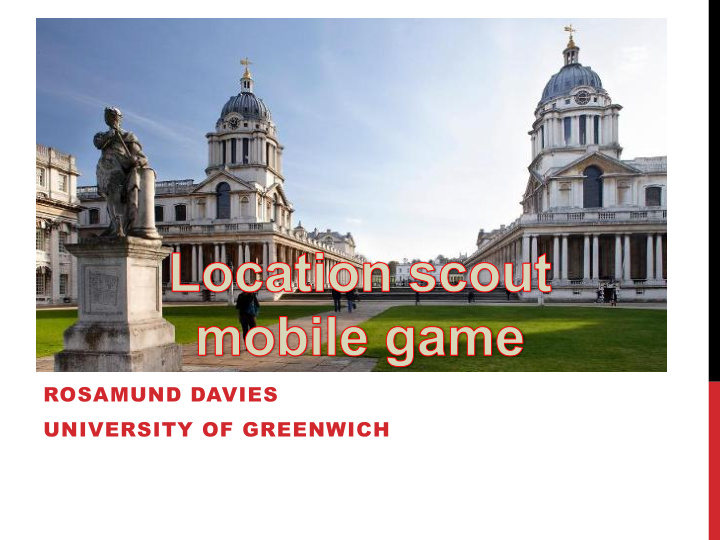



ROSAMUND DAVIES UNIVERSITY OF GREENWICH
BACKGROUND & INTRODUCTION The Old Royal Naval College (ORNC), Greenwich, is extensively used as a film location, its neo-classical architecture used to represent a range of sites of royal/ imperial/military/democratic power, both real and imaginary: Buckingham Palace: Patriot Games, The Madness of King George, The Queen, The Royals, The Crown Political & Military Buildings/Law courts/Seat of Learning: Patriot Games, The Four Feathers, The Golden Compass, Pirates of the Caribbean - On Stranger Tides, Gulliver’s Travels, Thor II Streets of Capital City: Sherlock Holmes I & II (London, Paris) Parade’s End (London), Les Miserables (Paris) Testament of Youth (London), The Dark Knight Rises (Rome), Muppets Most Wanted (Berlin) Gulliver’s Travels (Lilliput)
BACKGROUND & INTRODUCTION Visitors to the ORNC have shown a strong interest in its role as a film location: • A recent exhibition of film posters and stills from films shot on location at the ORNC attracted high numbers. • A recent activity day for ESL learners themed around films shot at Greenwich was also highly successful. The interpretation team is keen to build on this, particularly as part of their strategy for engaging with the 16- 25 demographic.
THE HISTORY OF THE ORNC Originally the site of the Tudor Greenwich Palace. Elizabeth I born here. Palace in disrepair after civil war. Half hearted attempts to rebuild it as a royal palace finally ended when it was pulled down at the end of 17 th century and redesignated as a site for a Royal Seamens’ Hospital by Mary II (William & Mary). Political and money problems meant the hospital took more than half a century to complete. It functioned as a hospital/ retirement home until 1869 when it was repurposed as a naval college. At the end of the 20 th century it became the main site of the University of Greenwich. The complex history and shifting function of the site makes it a difficult narrative with which to instantly engage visitors.
AN UNREALISED CHRONOTOPE? Bakhtin used the term ‘chronotope’ to define particular configurations of time + value + space + value in literary representations where ‘space becomes charged and responsive to the movements of time, plot and history’ (Bakhtin 1981: 84) & where time becomes ‘palpable & visible’ (ibid: 250): The agora – the town square and political centre of public life that framed classical Greek autobiography The road in the adventure/picaresque novel The space of parlours and salons in Stendhal and Balzac ‘All the novel’s abstract elements – philosophical and social generalizations, ideas, analyses of cause and effect – gravitate towards the chronotope and through it take on flesh and blood’ (ibid 250) Architecture produces meaning in similar ways. However the ORNC is an example of a chronotope where the real space seems insufficiently ‘charged and responsive to the movements of time, plot and history’.
THE OLD ROYAL NAVAL COLLEGE
CHRONOTOPES ON FILM The ORNC works more powerfully as a chronotope on film than in real life, because these films employ its architecture as an instant visual signifier of established cultural institutions within their narrative: The palace, the law court, the capital city
PIRATES OF THE CARIBBEAN
PIRATES OF THE CARIBBEAN
THE LOCATION SCOUT GAME An opportunity to use the instability of the ORNC as chronotope to give visitors an enjoyable experience via a critical reading of the architecture Aim: to encourage players to engage critically with the ORNC as a site of cultural meaning and narrative and explore how it might be refashioned through their own navigation of the space.
THE NARRATIVE FRAME The player is a location scout with the mission to find suitable locations within the ORNC complex of buildings for a number of scenes for a hypothetical film. As they carry out their mission they find out which scenes from which real-life films were shot in various locations around the site. Key question posed and answered: What has and could this location be used to represent?
THE GAME STORY The game story is the second level of story (in addition to the narrative frame), which is a crucial element in a mobile game (Bunting 2014). The game story is the player’s own experience of playing the game, of piecing together the story as they traverse the space. The choices they make, the actions they take form an important part of the overall narrative experience for participants. Key question we want to pose and answer: How and why does this architecture produce meaning?
AESTHETIC/TECHNICAL APPROACH Mainly audio content, possibly some text Participants will take photos and upload them to a database and will also have viewing access to photos of others via this database Probably a mobile application, but could be alternatives
KEY QUESTION - HOW BEST TO FACILITATE A SATISFYING GAME STORY? First stage is a paper trail prototype. A range of different trails will be designed structured around different foci of interest, e.g: • Particular sub locations within the complex • types of events represented in films • Interesting anecdotes • Characters and character types • Themes • Particular films Trial participants will be asked which topics and activities they find most interesting and satisfying and why
KEY QUESTION – HOW TO CREATE A COMMUNITY OF COLLABORATORS/PLAYERS? Suggestions welcome …
Recommend
More recommend